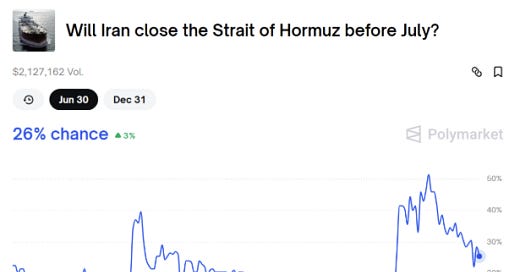Steno Signals #202 – Peak WW3 Fears Return!
Peak Panic, Missed Signals: Why Iran won’t shut Hormuz—and why copper, not crude, is the real trade right now.
Over the weekend, oil traders dusted off their Strait of Hormuz crisis playbooks—and once again, they overplayed their hand. Saturday’s U.S. strike inside Iran sparked a sharp wave of geopolitical anxiety, turbocharged by Iran’s retaliatory missile barrage and the familiar threat from Tehran’s Parliament to shut down the Strait. Add a few “Hormuz closed?” headlines and prediction markets went into meltdown, briefly treating a full blockade as the base case.
Let me be very clear: we do not buy it.
The U.S. signaled early—and deliberately—that its strike was a one-off. There’s even chatter that Tehran was warned in advance, allowing Iran’s leadership a chance to save face without being seen as capitulating to the West or Israel. This gives both sides a valuable off-ramp. Iran’s Parliament may talk tough, but the decision to close Hormuz doesn’t lie with a parliamentary vote—it lies solely with the Supreme Leader and his inner circle. And that circle understands one thing better than anyone else: closing the Strait would be suicidal.
Why? Because while Hormuz is a chokepoint for roughly 20% of global petroleum liquids, the strategic pain would fall disproportionately on Iran’s few remaining friends. Roughly 75% of Asia’s oil imports flow through Hormuz, compared to just 10–15% of Western oil. China alone pulls in over 1.6 million barrels per day via this route—mostly from Gulf suppliers like Saudi Arabia and Iraq—and more than 80% of its crude travels through the Strait. That means China would feel the heat immediately if Tehran pulled the trigger. A temporary shutdown would force Beijing into an expensive scramble, chasing spot barrels or racing to reroute logistics—both wildly costly propositions at a time when Chinese refinery margins are already under pressure.
And it’s not just oil. China and Qatar are now joined at the LNG hip. Qatar ships 21% of global LNG supply, much of it through Hormuz, and it recently signed 15 long-term LNG deals with China and the UAE, totaling nearly 30 million metric tons per year. As of earlier this year, Qatar became China’s top LNG supplier, overtaking Australia. Just one vessel collision in the Strait—let alone a full shutdown—would ripple through LNG spot and term pricing globally. That’s a risk Qatar can’t afford, and neither can China.
So ask yourself: would Iran really jeopardize its two most diplomatically friendly and economically crucial partners—just to make a point? Not likely. Iran has managed to maintain pragmatic trade relationships with both, and sabotaging them would be a self-inflicted wound. It would also send Asian LNG prices flying, spark spot crude volatility, and crush regional shipping liquidity. In short, it would make Tehran the arsonist of its own diplomatic safety net.
That’s why we exited our long oil position late last week—just ahead of the fear peak. Because unless the Ayatollah loses his grip on strategic rationality, we’ll see the usual playbook: oil gaps up, equities gap down... then both revert by Monday’s close. And that’s exactly what’s playing out.
If we’re right, today will mark peak WW3 panic—with very little justification.
Chart of the week: Markets entered “Hormuz panic mode” over the weekend
Keep reading with a 7-day free trial
Subscribe to Stenos Signals to keep reading this post and get 7 days of free access to the full post archives.



